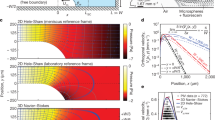Abstract
The experimental conditions of the sample delivery inside the reagent-release capillary-based capillary-assembled microchip (RRC-based CAs-CHIP) were optimized and the reagent release procedure in the RRC is discussed. Recently, our group introduced the basic concept of the “drop-and-sip” fluid handling technique (Anal. Chem., 2007, 79, 908). A microliter volume of sample solution is dropped on the inlet hole and is sipped into another hole, producing a sample plug flow in the main poly(dimethyl siloxane) (PDMS) channel, concurrently filling each sensing capillary that faces the main PDMS channel. However, the detailed evaluation of the successful sample delivery condition and the reagent release behavior in the RRC has not been fully discussed. Under our experimental conditions, ca. 0.6 - 2.4 s of sample plug-RRC contact time allowed the successful sample introduction into the RRC by capillary force without any reagent leakage or disturbance of the sample plug flow. On the other hand, reagent release behavior inside the RRC is governed by both convective and diffusive mass transport, which leads to a faster mixing time of the sample with reagents immobilized inside the RRC compared to that expected from the simple diffusion alone.
Similar content being viewed by others
References
R. E. Oosterbroek and A. van de Berg (ed.), “Lab-on-a-Chip. Miniaturized System for (Bio)Chemical Analysis and Synthesis.”, 2003, Elsevier, Boston.
A. Manz, N. Graber, and H. M. Widmer, Sens. Actuators, B. 1990, 1, 244.
P. S. Dittrich, K. Tachikawa, and A. Manz, Anal. Chem., 2006, 78, 3887.
K. Kitamori, H. Fujita, and S. Hasebe (ed.), “Proceeding of Micro-TAS 2006 Conference.”, 2006, Society for Chemistry and Micro-Nano Systems (CHEMINAS), Japan.
P. Woias, Sens. Actuators, B. 2005, 105, 28.
D. C. Duffy, H. L. Gillis, J. Lin, N. F. Sheppard, and G. J. Kellog, Anal. Chem., 1999, 71, 4669.
G. C. Randall and P. S. Doyle, PNAS. 2005, 102, 10813.
K. Hosokawa, M. Omata, K. Sato, and M. Maeda, Lab Chip. 2006, 6, 236.
M. Zimmermann, H. Schmid, P. Hunziker, and E. Delmarche, Lab Chip. 2007, 7, 119.
H. Hisamoto, Y. Nakashima, C. Kitamura, S.-I. Funano, M. Yasuoka, K. Morishima, Y. Kikutani, T. Kitamori, and S. Terabe, Anal. Chem., 2004, 76, 3222.
T. G. Henares, M. Takaishi, N. Yoshida, S. Terabe, F. Mizutani, R. Sekizawa, and H. Hisamoto, Anal. Chem., 2007, 79, 908.
H. Hisamoto, S.-I. Funano, and S. Terabe, Anal. Chem., 2005, 77, 2266.
H. Hisamoto, M. Yasuoka, and S. Terabe, Anal. Chim. Acta. 2006, 556, 164.
H. Hisamoto, S. Takeda, and S. Terabe, Anal. Bioanal. Chem., 2006, 386, 733.
T. G. Henares, S.-I. Funano, S. Terabe, F. Mizutani, R. Sekizawa, and H. Hisamoto, Anal. Chim. Acta. 2007, 589, 173.
T. G. Henares, F. Mizutani, R. Sekizawa, and H. Hisamoto, Sens. Mater., 2007, 19, 249.
S. Inadumi, H. Hisamoto, and F. Mizutani, Chem. Lett., 2007, 36, 1242.
Author information
Authors and Affiliations
Corresponding author
Rights and permissions
About this article
Cite this article
Henares, T.G., Mizutani, F., Sekizawa, R. et al. “Drop-and-Sip” Fluid Handling Technique for the Reagent-Release Capillary (RRC)-based Capillary-Assembled Microchip (CAs-CHIP): Sample Delivery Optimization and Reagent Release Behavior in RRC. ANAL. SCI. 24, 127–132 (2008). https://doi.org/10.2116/analsci.24.127
Received:
Accepted:
Published:
Issue Date:
DOI: https://doi.org/10.2116/analsci.24.127




